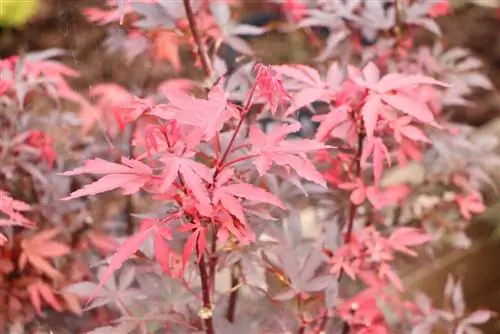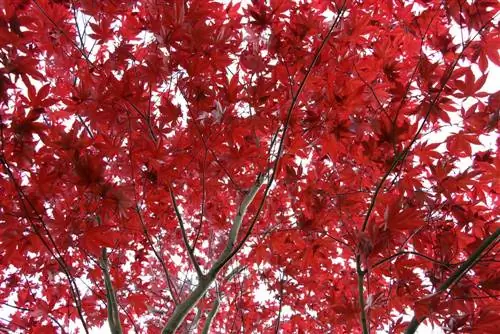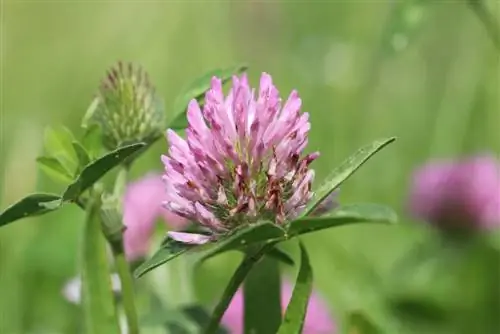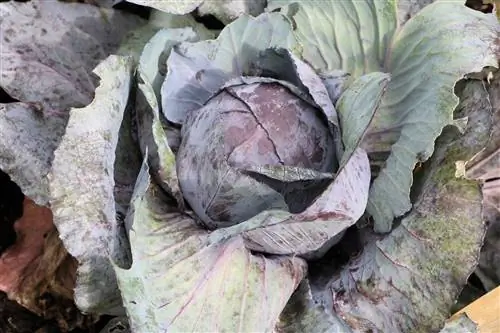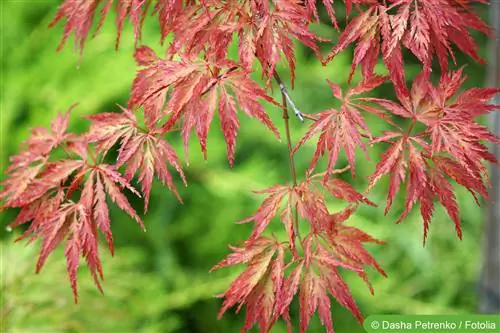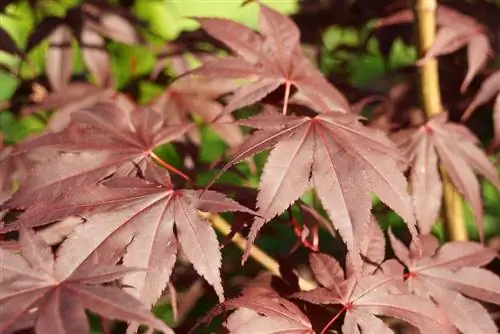- Author admin [email protected].
- Public 2023-12-17 03:39.
- Last modified 2025-01-24 12:45.
No tree genus demonstrates the alternation between growth and decay more spectacularly than the deciduous maple with brilliant autumn color. The top-class among the diverse species are Japanese maple as well as red and Japanese maple with magnificent varieties. From the dwarfish 'Shaina' for pot culture to the majestic 'Ornatum' as a solitaire, the perfect Acer is available for every design wish. Home gardeners appreciate that the diverse varieties pull together when it comes to care. The following care instructions are therefore applicable to all Asian maple trees that have slotted decorative leaves.
Location
Choosing a suitable location plays a central role in successful cultivation. Since Japanese maple and its counterparts are characterized by a high degree of flexibility, a wide range of location options are available to you.
This is what the ideal location should be like:
- Sunny to semi-shady location
- Beyond shade-casting trees or walls
- Happy to be warm and protected from the wind
Although the maple genus is not part of our region's natural inventory, the trees are so robust that they easily adapt to the Central European climate. A sunny northern location during the day is therefore just as acceptable as a sun-exposed southern orientation. In order for the foliage to undergo the spectacular transformation in autumn with the desired intensity, the location should be in full sun at this time of year.
Soil conditions and substrate
In their Asian habitats, maple trees primarily choose a location with loose, permeable forest soil up to 800 meters above sea level. A garden soil with the following properties meets the requirements for vital and he althy growth:
- Deep, nutrient-rich soil
- Fresh-moist, well-drained, without waterlogging
- Ideally slightly acidic, neutral to slightly calcareous
For cultivating dwarf varieties in pots, we recommend a structurally stable pot plant soil that is made more permeable with fine grit or quartz sand. The addition of leaf compost optimizes the nutrient content, as small maple varieties grow very slowly and remain in the substrate for a correspondingly long time. To improve stability, add a few handfuls of clay-containing garden soil, which is particularly useful in wind-exposed locations.
Tip:
In garden soil with an alkaline pH value greater than 8, problems in the cultivation of Japanese maple are inevitable. By incorporating ericaceous or rhododendron soil into the soil, you lower the pH value to a level suitable for maple trees.
Planting time
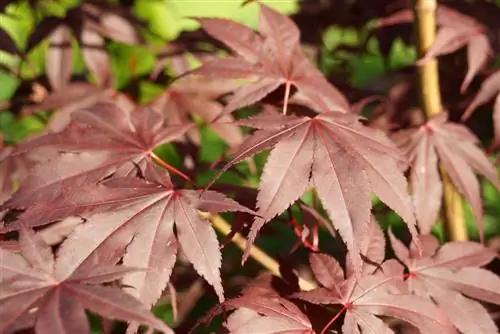
As immigrant trees, young maple trees are not yet completely hardy immediately after planting. Spring has therefore emerged as the best time for planting. Until the first frost, the young trees have a months-long acclimatization phase so that they are well prepared for the winter. Only in wine-growing regions with mild winters can autumn be considered as a planting time.
Plants
On the chosen date for planting Japanese maple, red or Japanese maple, the soil should be completely thawed. Delayed ground frosts must not be announced, otherwise the shallow root system of young trees could suffer frost damage.
How to properly plant a home-grown or purchased maple tree:
- Place the potted root ball in water until no more air bubbles appear
- Meanwhile, dig a planting pit with twice the circumference of the root ball
- Pour pebbles or grit on the sole as drainage against waterlogging
- Enrich the excavation with leaf compost, fine grit and horn shavings
Place the now potted maple tree in the middle of the pit. Next to the root ball, drive a wooden post into the ground in order to later tie the trunk to it and thus protect it from wind. While a helping hand holds the tree in place, fill in the enriched soil. The surface of the root disk should ultimately be just below soil level. Tamp the soil firmly and water thoroughly.
Planting in the pot is similar, with an air- and water-permeable fleece being placed between the drainage and the substrate. In this case, you can do without a support rod. It is important to note that at the end you water the root ball until the water runs out from the bottom.
Tip:
Freshly planted maple trees are sensitive to dog urine. To protect the young trunks from damage, plant the harp bush Plectranthus caninus in the immediate vicinity. This plant is also known as the 'piss off plant' or 'dog fright' and keeps the four-legged friends away with its smell.
Pouring
With increasing age, the need for watering your Japanese maple and its numerous conspecifics decreases. Immediately after planting and in the first three to four years, the rooting has not yet progressed to such an extent that a young maple tree can survive without additional watering. This is particularly true during dry summer periods and frost in winter.
How to water correctly:
- In the first 6 weeks after planting, water regularly and abundantly, without waterlogging
- During the first 4 years, water whenever the soil has dried to a depth of 2 cm
- In summer droughts, run the water hose twice a week for 20 to 30 minutes
- Always allow water to flow directly onto the root disk
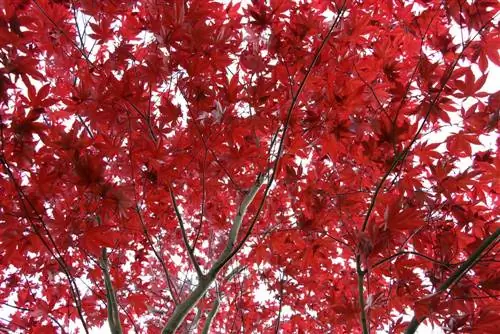
While normal rainfall covers the water requirements of well-rooted, adult maple trees, dwarf maples in pots can never do without regular watering. Due to the exposed location of the root ball and the small substrate volume, the soil dries out quickly. Therefore, check at least once a week using a thumb test to see whether the plant soil has dried out. Let the water flow out of the jug spout until the saucer fills up. After 10 minutes, please pour out the coaster to avoid waterlogging.
Fertilize
Nutrition needs your attention only at the beginning of the gardening season. In May or June you can stimulate the growth of your maple tree with a slow-release fertilizer. A long-term fertilizer with a sustained release effect is well suited. Sprinkle the granules on the root disc and water again. Please avoid incorporating the fertilizer with a rake. All maple species thrive as shallow-rooted plants, with the vital fine root system located directly below the surface of the earth. By raining on the fertilizer, the nutrients reach the roots without damaging the roots with a rake.
Cutting
Japanese maple as well as red and Japanese maple are naturally blessed with a perfectly formed growth habit that can hardly be improved by pruning. Since this tree genus does not tolerate pruning well anyway, the topic of pruning is rarely part of the care program. In order to regulate the size growth in the bed and pot or to free the crown from ballast, it can still make sense to use scissors.
How to proceed professionally:
- Short shoots that are too long in summer
- Place the scissors at a short distance from a sleeping eye
- Cut off dead branches on Astring
Please do not cut into the old wood. As a rule, a maple tree does not sprout again at this point. As gardening practice has shown, pruning in autumn and winter is disadvantageous for a maple tree. In the middle of the summer growing season, the cuts close more quickly, so that diseases and pests have less of a target.
Tip:
On refined maple varieties, wild shoots emerge from the rootstock from spring to autumn. These water shoots grow much faster than the branches in the refined crown. Therefore, promptly cut off any wild shoots that catch your eye.
Overwintering in the bed
Thanks to their adaptability, adult maple trees are completely hardy. This frost tolerance gradually builds up over the first 4 to 5 years. In this way, the following protective measures ensure that a young Japanese maple, red or Japanese maple survives the rigors of the cold season well:
- Before the onset of winter, spread a thick layer of leaves on the root disc
- Place brushwood around the young tree as a windbreak
- Alternatively, protect the young tree with a reed mat
If the winter weather is characterized by frost, with no snow and the sun shining, maple trees are threatened by drought stress. Therefore, on mild days, water young and adult specimens equally.
Overwintering in a bucket
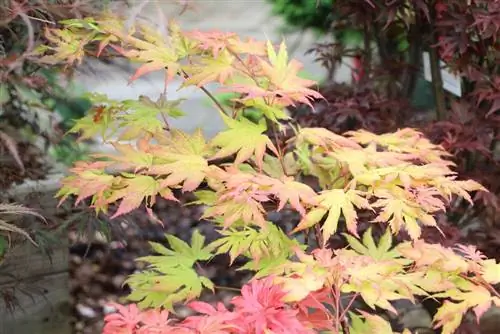
In the pot, the root ball of your maple is in a vulnerable position to frost and cold wind. A more extensive strategy is required here so that the Asian tree does not suffer any damage.
How to do it right:
- Place maple in a bucket in front of a protective house wall
- Place the pot on a wooden or Styrofoam base
- Wrap with bubble wrap
- Put a coconut mat over the foil so that it extends a few centimeters beyond the edge of the pot
Please put pots with a diameter of less than 30 cm in the bright winter quarters. At 2 to 5 degrees Celsius, water only enough to prevent the soil from drying out. As soon as there are no longer any fears of frosty nights, the maple tree moves to its original location in the open air.
Diseases and pests
Plant and care for your Japanese maple, red maple and Japanese maple according to these instructions, diseases and pests will not cause you any headaches. In soil that is too dry, wet or poor, the tree's defenses suffer, meaning that pathogens have an easy time of it. We have summarized the most common problems for you below with tips for poison-free control:
Mildew
Too dry soil and summer drought cause the fungal infection mildew to appear. The infestation can be recognized by mealy-gray to mealy-white spots on the leaves. Cut off all affected leaves. In the early stages it is not necessary to use chemical fungicides. A mix of an eighth of a liter of fresh milk and a liter of water has proven to be an effective control agent. Spray the diseased maple once a week until there is no more white growth.
Verticillium Wilt
Wet soil and waterlogging cause another fungal disease. The maple is one of the most important host plants for the dreaded Verticillium wilt. The first symptoms of infection are pale green leaves that wilt even though you water regularly. Effective fungicides are not yet available. Cut out diseased branches and optimize the site conditions to strengthen the tree's defenses. If the pathogens have not yet completely colonized the pathways, the tree's self-healing powers can be activated and the disease can be cured from the inside out.
Aphids
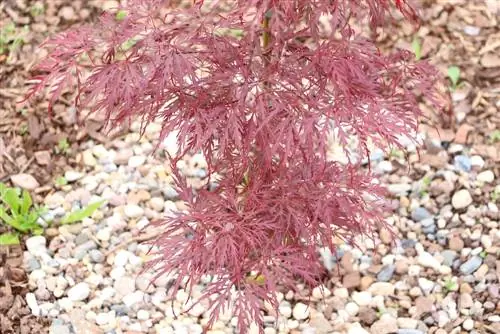
A Japanese maple weakened by a lack of nutrients cannot defend itself from an attack by aphids. The same goes for red and Japanese maples. The sucking pests are particularly booming in July and August. Therefore, regularly examine the tops and bottoms of the leaves in order to discover the green, brown, white or reddish lice in good time. It has been proven that the classic soap solution is just as effective in combating it as chemical insecticides.
How to do it:
- Bring a liter of water to the boil
- Dissolve 50 grams of pure curd soap in it
- Pour the cooled solution into a hand or pressure sprayer
Treat the entire foliage of the affected maple on the bottom and top surfaces. Since home remedies are rarely successful after a single application, repeat the soapy water treatment every two to three days. Please note that commercial soap products are not suitable for this purpose. Only when you no longer see aphids even with a magnifying glass will your Japanese maple be aphid-free.
Conclusion
With their multifaceted and shapely varieties, Japanese maple as well as red and Japanese maple are predestined to be house trees for small and large gardens. In order to enjoy the decorative foliage structures and furious autumn colors, the Asian ornamental trees require little care from the gardener. Planted in a sunny to partially shaded location in humus-rich, nutrient-rich soil in spring, the young trees feel warmly welcome in the garden. In the first few years there is plenty of watering in summer, whereas adult maple trees make do with the rainfall. The nutrient requirements are covered with initial fertilization in spring. Their naturally beautiful habit does not require annual trimming and maintenance. The only time that maple trees require an increased amount of work is when their magnificent leaves fall to the ground before winter and have to be disposed of.

